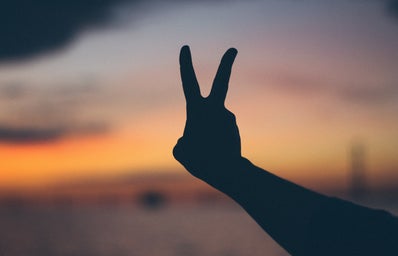In November of 2020, I was diagnosed with a panic disorder. It was the darkest period of my life and I still have trouble looking back on it. Despite barely sleeping and panicking almost every day, I somehow maintained a 4.0 gpa for the Spring semester of 2021 and received a President’s scholar award, which is one of my biggest flexes. I refused to let my condition get in the way of my education, and I pushed myself forward to complete my sophomore year. I felt absolutely horrible, and it couldn’t have been possible without my compassionate professors who helped me catch up on work and gave me a multitude of extensions on assignments.
My panic disorder lasted 7 months in total. Some weeks were better than others, sometimes I would have only one panic attack a week, and other times I would have 3 to 5 panic attacks a day. It got to the point where I stopped sleeping because everytime I fell asleep I would wake up in the middle of a panic attack at 3 a.m. I had bags under my eyes, I lost an incredible amount of weight, and I felt like a shell of myself.
The difference between an anxiety and panic attack is that anxiety attacks often stem from pre-existing thoughts of worry and anxiety and are often triggered by specific things, while panic attacks can occur with no trigger and can happen at the most unexpected moments. According to McLean Hospital–part of the Harvard Medical school, symptoms of panic attacks include lightheadedness, chest pain, hot flashes, chills, and stomach discomfort.
“Some say they feel like they were being choked or suffocated. Others say an attack made them feel “detached from reality (McLean Hospital).” The most common symptoms I had during panic attacks were the pains and aches, the choking sensation and feeling unable to breathe properly, and the detachment from reality.
I had no warning when I had panic attacks. I tried everything I could to stay calm; I started painting everyday, laying in the sun, exercising more, eating fruits and veggies, but even when I was painting and happily enjoying my day, I would have a panic attack. It’s out of your control, which is why they can be so devastating.
Overcoming Driving Anxiety & Panic Attacks
One of the worst panic attacks that triggered the disorder happened when I was driving on the freeway. I had to quickly exit and pull off into a parking lot because I felt like my throat was closing and I couldn’t breathe. I called my boyfriend to come meet me while I tried to stabilize. At the time I didn’t know this panic attack would have the potential to become a bigger obstacle in my life and prevent my ability to drive in the future. I remember crying and panicking every time I tried to get behind the wheel for over a month. Everytime I pulled up to a stoplight I felt trapped and caged in. I cried every time I would get another panic attack, and ended up having to be driven by my boyfriend or family members because I was unable to get behind the wheel without hyperventilating. It absolutely broke my heart because driving was one of my favorite hobbies. It was my escape from the world where I could play my favorite songs and sing in my car. I felt useless not being able to transport myself like I used to.
My love for driving is what got me over my driving anxiety.
No matter how anxious or how many panic attacks I got, I forced myself to drive for at least 20 minutes to 1 hour a day. I often had to pull over and cry periodically but I was not going to give up something I used to love. I started off only driving residential roads before I had the strength to go back onto the freeway.
When I finally started driving on the freeway again, it often caused me panic attacks. I would be fine on residential roads, but on the freeway I felt trapped. I would get scared that I was gonna have a panic attack and have nowhere to pull over. I was terrified of driving in the inner lanes and only drove in the far right lane for 5 months in fear that I might need to exit at the last minute. Eventually I forced myself to merge and drive on the inner lanes, one lane at a time, but it was a huge obstacle for me to finally reach the left most (carpool) lane without having a panic attack. I’m proud to say that I’ve been able to drive long distances on freeways successfully since this happened, and getting over driving anxiety is possible. It took a lot of patience and tears, but I can proudly say that I overcame my driving anxiety completely in 7 months. I drove all the way to Los Angeles last Summer, Santa Barbara multiple times, and all over the Bay Area.
The Moments I’m not Panicking
When you have panic attacks everyday, you start to savor every moment of stability where you feel safe and can breathe. I started to be grateful for every moment of peace I had in my life, because I never knew how long it would last. I noticed a pattern in my panic attacks–they occurred mostly after the sunset. So during the daytime, I would complete my online classes and drive around to my favorite places. I would go to Target and just walk around, get some coffee, read at Barnes & Noble, walk along the beach, and just enjoy being outside alone. I learned to love the company of myself and appreciate the small things that make me happy: iced coffee, matcha lattes, shopping sales, making dollar tree flower bouquets, magazine collages, painting gifts for my friends, going to Asian markets, eating Filipino snacks, and sunbathing. These are all very simple things that bring me joy, but doing small activities that warm your heart can have a tremendous impact on your mental health when you are low.
I still get a panic attack once in a while, but it’s very rare. I’ve only had 2 or 3 since June 2021, which is a major improvement compared to my history. The important thing is to not feel like a failure when you do have a panic attack again. I used to look at it like I ruined my streak of no panic, but it’s a negative mindset to put yourself in and only makes you feel worse about yourself. Instead appreciate the small wins, like “My panic attack only lasted 3 minutes today!” which is shorter than last time.
Tips and tricks if you feel anxious or panicky
- Ice is your best friend. Keep a cold drink with you at all times, especially if you have driving anxiety. You can hold it to your neck and sometimes feel yourself snap out of a panic attack.
- MINTS. Mints, hard candies, vitamin C drops, are all my best friends. If you are feeling super anxious or on the verge of panic, throw a few Altoid mints in your mouth so that you feel a burning minty sensation in your mouth. I find that it helps me keep calm when I’m sucking on a mint or candy in stressful situations. Most tests I’ve taken in high school in college were while I sucked on a mint because it helps me relax.
- Suck on something sour. I have seen firsthand how well this works on people who are mid-panic attacks. Suck on a lemon, lime, sour patch candy, anything sour can make you snap out of your panic attack.
- Rootd is a great app for panic attacks that helps talk you through your attack and remind you that panic attacks aren’t forever, and the sensations will end soon. There is a red button on the app if you feel like you are about to have a panic attack. This app got me through many hard months of my panic disorder and I found it successfully helped me.
Recovery
The thing many people don’t know about panic attacks is you also have to take time to recover from them. After a panic attack, I would have lingering symptoms for hours to days, feeling completely drained and unable to do many activities. Make sure to take time for yourself and lay in bed all day if you want to, take a nap, have a bowl of soup, go lay on the beach, do anything that makes you feel whole again.
My panic disorder kept me in a loop of attacks because I was most afraid of having more panic attacks. The fear of the panic itself is what made me continue to have them. When I started to remove the fear and stop being so afraid of them, I saw myself heal over time and slowly become myself again. I no longer suffer from a panic disorder, I can drive on freeways for hours, go grocery shopping without an attack, sit through exams and tests at school, and ultimately live my life again.


